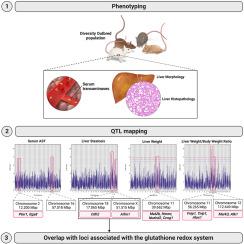当前位置:
X-MOL 学术
›
Redox Biol.
›
论文详情
Our official English website, www.x-mol.net, welcomes your feedback! (Note: you will need to create a separate account there.)
Discovery of genomic loci for liver health and steatosis reveals overlap with glutathione redox genetics
Redox Biology ( IF 10.7 ) Pub Date : 2024-06-19 , DOI: 10.1016/j.redox.2024.103248 Rebecca L Koch 1 , James B Stanton 2 , Susan McClatchy 3 , Gary A Churchill 3 , Steven W Craig 1 , Darian N Williams 1 , Mallory E Johns 1 , Kylah R Chase 1 , Dana L Thiesfeldt 1 , Jessica C Flynt 1 , Robert Pazdro 1
Redox Biology ( IF 10.7 ) Pub Date : 2024-06-19 , DOI: 10.1016/j.redox.2024.103248 Rebecca L Koch 1 , James B Stanton 2 , Susan McClatchy 3 , Gary A Churchill 3 , Steven W Craig 1 , Darian N Williams 1 , Mallory E Johns 1 , Kylah R Chase 1 , Dana L Thiesfeldt 1 , Jessica C Flynt 1 , Robert Pazdro 1
Affiliation

|
Non-alcoholic fatty liver disease (NAFLD) is the most common chronic liver condition in the United States, encompassing a wide spectrum of liver pathologies including steatosis, steatohepatitis, fibrosis, and cirrhosis. Despite its high prevalence, there are no medications currently approved by the Food and Drug Administration for the treatment of NAFLD. Recent work has suggested that NAFLD has a strong genetic component and identifying causative genes will improve our understanding of the molecular mechanisms contributing to NAFLD and yield targets for future therapeutic investigations. Oxidative stress is known to play an important role in NAFLD pathogenesis, yet the underlying mechanisms accounting for disturbances in redox status are not entirely understood. To better understand the relationship between the glutathione redox system and signs of NAFLD in a genetically-diverse population, we measured liver weight, serum biomarkers aspartate aminotransferase (AST) and alanine aminotransferase (ALT), and graded liver pathology in a large cohort of Diversity Outbred mice. We compared hepatic endpoints to those of the glutathione redox system previously measured in the livers and kidneys of the same mice, and we screened for statistical and genetic associations using the R/qtl2 software. We discovered several novel genetic loci associated with markers of liver health, including loci that were associated with both liver steatosis and glutathione redox status. Candidate genes within each locus point to possible new mechanisms underlying the complex relationship between NAFLD and the glutathione redox system, which could have translational implications for future studies targeting NAFLD pathology.
中文翻译:

肝脏健康和脂肪变性基因组位点的发现揭示了与谷胱甘肽氧化还原遗传学的重叠
非酒精性脂肪肝病 (NAFLD) 是美国最常见的慢性肝脏疾病,涵盖多种肝脏病理学,包括脂肪变性、脂肪性肝炎、纤维化和肝硬化。尽管 NAFLD 的患病率很高,但目前美国食品和药物管理局还没有批准用于治疗 NAFLD 的药物。最近的研究表明,NAFLD 具有很强的遗传成分,识别致病基因将提高我们对 NAFLD 分子机制的理解,并为未来的治疗研究提供目标。众所周知,氧化应激在 NAFLD 发病机制中发挥着重要作用,但氧化还原状态紊乱的潜在机制尚不完全清楚。为了更好地了解遗传多样性人群中谷胱甘肽氧化还原系统与 NAFLD 症状之间的关系,我们测量了肝脏重量、血清生物标志物天冬氨酸转氨酶 (AST) 和丙氨酸转氨酶 (ALT),并对一大群多样性的肝脏病理学进行了分级近交系小鼠。我们将肝脏终点与之前在同一小鼠的肝脏和肾脏中测量的谷胱甘肽氧化还原系统的终点进行了比较,并使用 R/qtl2 软件筛选了统计和遗传关联。我们发现了几个与肝脏健康标志相关的新基因位点,包括与肝脏脂肪变性和谷胱甘肽氧化还原状态相关的位点。每个基因座内的候选基因都指出了 NAFLD 和谷胱甘肽氧化还原系统之间复杂关系背后可能的新机制,这可能对未来针对 NAFLD 病理学的研究产生转化意义。
更新日期:2024-06-19
中文翻译:

肝脏健康和脂肪变性基因组位点的发现揭示了与谷胱甘肽氧化还原遗传学的重叠
非酒精性脂肪肝病 (NAFLD) 是美国最常见的慢性肝脏疾病,涵盖多种肝脏病理学,包括脂肪变性、脂肪性肝炎、纤维化和肝硬化。尽管 NAFLD 的患病率很高,但目前美国食品和药物管理局还没有批准用于治疗 NAFLD 的药物。最近的研究表明,NAFLD 具有很强的遗传成分,识别致病基因将提高我们对 NAFLD 分子机制的理解,并为未来的治疗研究提供目标。众所周知,氧化应激在 NAFLD 发病机制中发挥着重要作用,但氧化还原状态紊乱的潜在机制尚不完全清楚。为了更好地了解遗传多样性人群中谷胱甘肽氧化还原系统与 NAFLD 症状之间的关系,我们测量了肝脏重量、血清生物标志物天冬氨酸转氨酶 (AST) 和丙氨酸转氨酶 (ALT),并对一大群多样性的肝脏病理学进行了分级近交系小鼠。我们将肝脏终点与之前在同一小鼠的肝脏和肾脏中测量的谷胱甘肽氧化还原系统的终点进行了比较,并使用 R/qtl2 软件筛选了统计和遗传关联。我们发现了几个与肝脏健康标志相关的新基因位点,包括与肝脏脂肪变性和谷胱甘肽氧化还原状态相关的位点。每个基因座内的候选基因都指出了 NAFLD 和谷胱甘肽氧化还原系统之间复杂关系背后可能的新机制,这可能对未来针对 NAFLD 病理学的研究产生转化意义。
















































 京公网安备 11010802027423号
京公网安备 11010802027423号